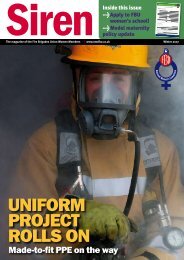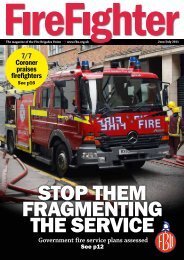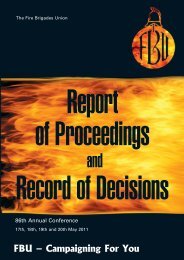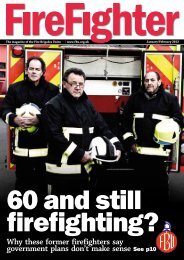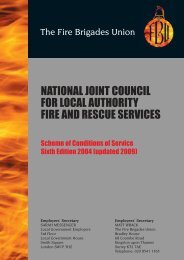Draft London Safety Plan 2010/2013 - Fire Brigades Union London
Draft London Safety Plan 2010/2013 - Fire Brigades Union London
Draft London Safety Plan 2010/2013 - Fire Brigades Union London
You also want an ePaper? Increase the reach of your titles
YUMPU automatically turns print PDFs into web optimized ePapers that Google loves.
MAPPING OUR PREVENTION PRIORITIES<br />
To prepare for our community and regulatory safety<br />
strategies, (published in November 2008), we mapped<br />
out the whole of our service by looking at the numbers<br />
and different types of incidents we attend and the<br />
number of casualties they cause. We can then consider<br />
what, if anything, we could do, or wanted to do, to<br />
prevent them. An illustrative chart of that data is<br />
represented below.<br />
From this work we have determined our prevention<br />
priorities as follows;<br />
1. <strong>Fire</strong>s – we attend around 600 fires a week, with a<br />
casualty rate of around five<br />
casualties for every 100 incidents.<br />
1000<br />
Our approach to preventing fire<br />
focuses on the places and causes<br />
where we think education (or<br />
regulation) will change behaviour to<br />
100<br />
avoid unnecessary fires.<br />
2. False alarms to automatic fire<br />
Advice<br />
alarms – we encourage the<br />
installation of fire detection and<br />
10<br />
alarm systems as the early warning<br />
they give is vital to preventing harm<br />
and reducing damage. However,<br />
1<br />
where automatic fire alarm systems<br />
are installed in non-domestic<br />
buildings they can often be<br />
inadequately maintained, poorly positioned or<br />
negligently activated. These situations give rise to<br />
around 1,000 false alarm calls per week. These false<br />
alarms are an unnecessary demand on our resources<br />
and we believe proper managerial controls by their<br />
owners will reduce these calls.<br />
3. People shut in lifts– we attend around 250 calls to<br />
people shut in lifts each week. We will always<br />
respond to these types of calls where there is a<br />
genuine emergency but there are a number of<br />
buildings in <strong>London</strong> where poor maintenance and<br />
managerial control means we are repeatedly<br />
attending to faulty lifts. We have begun to take<br />
action to reduce our attendance to calls where there<br />
is no immediate emergency and to charge those who<br />
persistently neglect to make better maintenance<br />
arrangements.<br />
4. Malicious calls – we have been very successful in<br />
reducing the number of hoax calls we attend, but we<br />
will continue to educate, identify and prosecute<br />
individuals who make hoax calls.<br />
5. Transport incidents (which includes road traffic<br />
accidents) – Road traffic accidents cause more<br />
Incidents per week (average)<br />
Automatic fire alarm<br />
Good intent false alarm<br />
Malicious false alarm<br />
15<br />
casualties than any other incident type we attend.<br />
We believe that many more of these incidents should<br />
and can be prevented and that those bodies charged<br />
with road, transport and traffic management can<br />
have the most impact on achieving that. However,<br />
we are very keen to work with them on programmes<br />
and initiatives that they design and implement.<br />
Together, these five incident types account for around 78<br />
per cent of the incidents we attend and 85 per cent of all<br />
casualties 3 we attend.<br />
Figure 2: graphical representation of our<br />
Mapping our prevention priorities (whole of service)<br />
Persons shut in lifts<br />
Flooding or water provision<br />
Animal rescue<br />
prevention priorities<br />
No action required<br />
3 If transport incidents are excluded, then we are directly trying<br />
to prevent around 75 per cent of the incidents we attend and 31<br />
per cent of the casualties.<br />
<strong>Fire</strong>s<br />
Effecting entry or exit<br />
Making safe<br />
Transport incidents<br />
Assistance to people<br />
0.00 0.01 0.10 1.00 10.00 100.00<br />
Casualties per 100 incidents (average)





